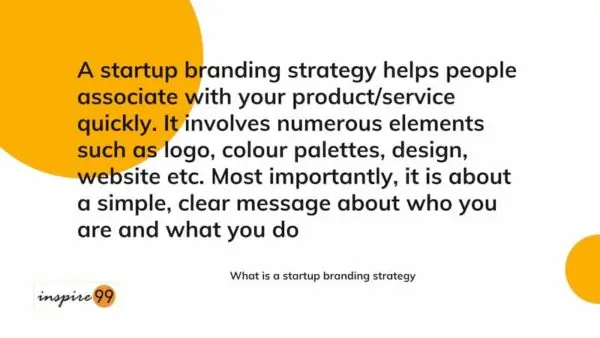Startup branding: We tend to associate brands to large companies. But startups and even individuals have our own brands. They come up in the form of consistent words, images and our communications that we use with people. A startup branding strategy is about creating this consistent engagement with your customers. In this article, we talk about the meaning of a startup branding strategy, its importance and practical steps to build your branding strategy.
As a necessary pre-read, I’d recommend going through, Startup vs small business, types of startup and funding strategies.
What is startup branding?
A startup branding exercise is the strategy to help people associate with your product/service quickly. The most common challenge startups face is in defining the problem and how they solve it. Most of the early startup branding pitches we wrote were long paragraphs that were complex and difficult for customers to follow. It resulted in us spending a lot of time trying to explain what we really were.

The outcome was that it made us less memorable because we were difficult to comprehend. A startup branding strategy should help you simplify and define who you are. Think simplicity, ease of understanding. If you’re spending a lot of time clarifying, you’re probably too complex and risking alienating both investors and customers.
A startup branding strategy involves numerous elements such as logo, colour palettes, design, website etc. But most importantly, it is about a simple, clear message about who you are and what you do. (Related: What is a brand?)
Why is branding important for entrepreneurs?
Branding is important for startups and entrepreneurs for these top 3 reasons:
- Help people associate with you
- Easily define what you are
- Simplify your approach
My key takeaway here is not to spend too much time, these have to be workshop exercises where you come up with a few test statements and test their working. You’ll have the opportunity to revise, repair and improve these with time. Particularly for early stage startups, your product building and understanding customer are the top two activities that will consume your time. Branding helps to create association with customers, potential investors and to explain in simple terms what your product is about. (Related: Importance of branding in business)
In my experience as an entrepreneur, the top mistakes I did were:
- Use too many words to define the brand because we always felt that we had to tell everything that we thought was fascinating. Instead, people like simplicity and clarity. Trust me, it takes time to come up with simple statements
- Tried to sound very good and comprehensive. You have a beautiful advantage as a startup – willingness to adapt and take feedback. By trying to sound too perfect, we blocked some honest conversations with people at the cost of appearing arrogant. In retrospect a humble truth would’ve gotten us a long way.
How to build a startup brand?
As an entrepreneur, brand building is a continuous exercise. Not only do you have to develop your business, but also continuously think about how to build user perception around it. Thankfully, your business plans, pitching experiences will set you up nicely for this brand building approach. Here are a few common tips to build a startup brand.
Product Positioning
This is one of the most important steps you can take towards startup branding strategy. Most founders try to jump straight into a marketing exercise without considering the strategy behind it. A short term sales approach is an awful way to build a startup brand. The investors will respect your ability to take measured steps and define how you want the product to be perceived.
In order to do this, map out your competitors and identify the customer needs they serve. It gives you a clear idea about gaps in the market. You can later conduct customer interviews to identify how important this gap is in the market. Along with this, you can also focus on identifying the value of such a need to influence your startup pricing strategy.
While developing your startup positioning, a positioning statement is a great way to clearly articulate your approach. A product positioning statement looks like
We offer [PRODUCT/SERVICE] for [TARGET MARKET] to [VALUE PROPOSITION]. Unlike [THE ALTERNATIVE], we [KEY DIFFERENTIATOR]
Product positioning statement
Define words associated with your startup
Use the what 3 words approach. This is a simple way to define your startup/product in 3 simple words. The rule of 3 helps you maintain simplicity. As a founder, I wanted to tell everything about the product causing multiple statements and confusions to the listener. The best and most difficult thing you can do is come up with some simple terms that can define your product.
Make sure that you don’t start listing your product features while defining your startup. It is all about the customer and the problem that you’re solving. Very few customers will care about the product- the problem and its resolution are more important. You can define how you’re special in your USP.
Express your USP
A USP the unique selling proposition for any business. It is something that differentiates you from numerous other competitors in your market. While developing your business plan, make sure that you spend time to construct your USP. It not only tells how you’re special but also indicates why you’re best placed to be solving this problem.
In a startup, you have the unique ability to respond quickly to the market demand which a large company can’t easily do. Make sure that you establish this USP clearly. Not only will your customers love it, the investors will demand it during your fundraising activities. (Related: How to define your USP)
Vision statement, Mission and Purpose
We love associating ourselves to a specific purpose and outcome. It tells the customers about what you truly care for. It also gives a clear picture of why you exist as a business. Yes, your solution is probably the most important thing, but people will respect your purpose and motivation.
A vision statement helps to clearly articulate the future that you imagine for your business. You may not be able to solve all these things yet, but the marketing statement and startup branding exercise can take your users along with you in this journey. Remember, it is not about the final destination alone, but the path that you take to achieve it.
Note, that it is a way to tell your story to the external world – you’re doing precisely that while creating a vision statement for your branding strategy.
Standardisation – Logo, colours, fonts etc
One of the hallmarks of a startup branding strategy is consistency in your communication. Your communication is not just about the words that you use but also about the image you create. Create a simple, standard set of logos, templates etc that you want to use. Then make sure that you follow this consistently while communicating to users. This can be in the form of word documents, presentations, landing page of websites etc.
In this branding strategy, you’re creating an association for users to you. A consistent set of images, representations helps someone to connect to you and associate an image of what you’re about.

Pingback: You don't need to be the biggest brand in the world - Inspire99
Pingback: Branding Hacks for E-Commerce - Inspire99
Thank you for sharing this. We are also on the start-up journey while figuring out how to create a remarkable brand for our audience. searching for tips and tricks we came across this blog which is very useful for us, thank you once again for this and share this kind of information with people like us.
Thank you Kapil, your reply is very kind – please do let me know if you have any topics in mind – I’d like the content to be useful and be able to provide real value :)
Pingback: 6 Key steps in building your Startup Branding strategy - Inspire99